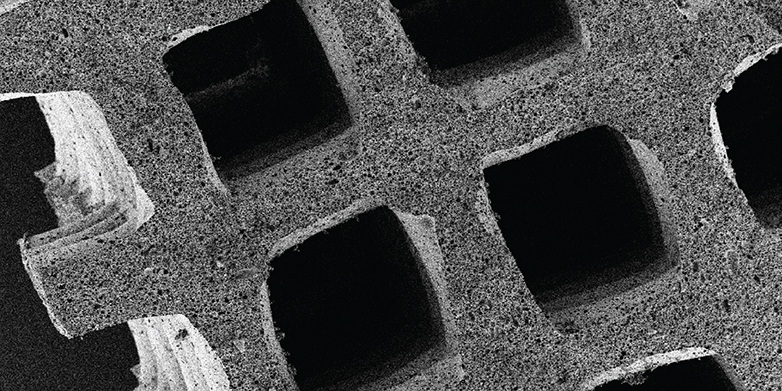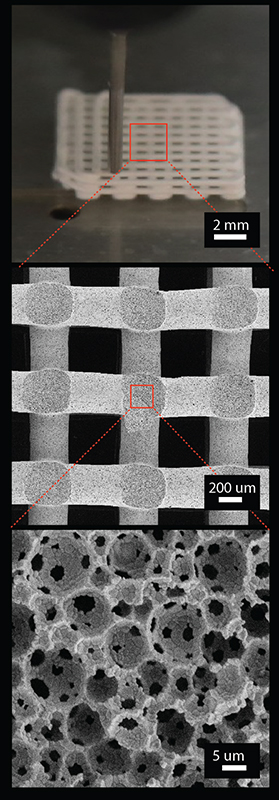Ceramics 3D printed from foams
ETH researchers have used an additive manufacturing process to print an extremely porous ceramic component. Manufacturing a material of this kind with a 3D printer is a considerable achievement.

Doctoral student Carla Minas, from the Complex Materials group led by ETH Professor André Studart, has succeeded in creating a highly porous and yet extremely robust ceramic material, which she “printed” using an additive manufacturing process. The trick here was to use an “ink” consisting of a stable ceramic emulsion that did not collapse during or after printing. Using this technique, it is possible to manufacture complex porous structures like those found in nature in the form of bones or diatoms.
The materials scientists have recently published details of the process and properties of the resulting ceramic foam in the journal Advanced Materials.
Using oil and a kitchen blender
For the 3D printing, the researcher used both a foam and an emulsion consisting of an aqueous solution, ceramic particles of aluminium oxide (Al2O3), and certain additives. The foam contains bubbles filled with air while the emulsion contains oil droplets. The researchers can use both forms for printing, albeit with different resulting pore sizes.
The suspension on which the process is based was developed at an earlier stage by researchers working in Studart’s laboratory. Minas used this suspension to produce an emulsion by adding oil and stirring vigorously. This created oil droplets of varying sizes that were surrounded by ceramic particles. During this step, the ceramic particles were altered so that they would be favourably located on the surface of the droplets. This coating of particles stabilises the droplets and prevents them from fusing with neighbouring droplets. A high proportion of oil creates a dense network of stabilised droplets. Furthermore, the ceramic framework prevents destruction of the pore structure during the following steps of the process, consisting in drying and firing of the 3D printed material.
Viscosity increases with oil and particle content
This network forms the basis for the specific flow properties required for 3D printing. It is even possible to adjust the particle size and thus the subsequent pore volume. “This depends on the viscosity of the paste. The higher the particle and oil content, the more viscous the ceramic emulsion and the smaller the droplets will become”, Minas explains.
As a further additive, she used polyvinyl alcohol (PVA), a short-chain polymer. This also accumulated favourably at the interface between the oil and water, repelling particles from the ceramic coating surrounding the droplets. The PVA molecules act as placeholders for extremely fine channels that connect neighbouring droplets with one another.
Using direct ink writing, a common technique in additive manufacturing, the researcher then printed a three-dimensional lattice structure using the ceramic emulsion. This structure was dried at room temperature and then fired in the kiln at 1,600°C. Drying caused the oil to evaporate, while the firing process destroyed the PVA molecules and compacted the ceramic coating around the pores. This left a hard ceramic framework in which the pore structure of the foam was perfectly preserved.
Pores connecting pores

The ceramic framework exhibits pores in up to three orders of magnitude: the largest pores are formed by the lattice structure with a freely tunable mesh size. The next grade of pores is created by the oil droplets, and the smallest by the PVA. Although the pores account for up to 95 percent of the material’s volume, the material is extremely robust in mechanical terms, as demonstrated by compression tests.
“Until now, lattice structures whose filaments have no pores have also been referred to as foam”, says André Studart. “However, our structure is an actual foam”, continues the ETH Professor, “as each filament is porous and the pores are in turn connected to one another by pores. Of course, examples of such materials can be found in nature: the structure of bones, bamboo and wood is based on a similar principle”.
The principle of 3D printing with ceramic-stabilised emulsions and foams can be applied not only to aluminium oxide but also to a variety of other ceramics. Moreover, the researchers were able to combine several “inks” in a single printing process, allowing them to manufacture complex structures with different material gradients. Depending on the application, the material and its structure can thus be optimised to achieve maximum performance.
Suitable for industry
The research aimed to create a material with maximum mechanical strength for minimum material expenditure – properties that are essential for lightweight construction materials. Furthermore, the material’s high porosity at different length scales permits a maximum flow rate through a structure with a large surface area. Ceramic structures manufactured using this method would therefore be well-suited to use as catalysts in the chemicals industry, in biomedicine, or indeed in the energy sector, for which Studart’s researchers developed the ceramic foam. The IBM Research Center in Rüschlikon (Zurich) is currently carrying out intensive research into possible ways to use residual heat to heat and cool houses without the need for additional energy. This requires materials that can absorb water particularly efficiently and release heat in the process. Optimized architectures for such applications can be fabricated by printing foams and emulsions.
The project was carried out as part of the National Research Programme “Energy Turnaround” (NRP 70), in which Studart’s group is participating.
Reference
Minas C, Carnelli D, Tervoort E, Studart AR: 3D Printing of Emulsions and Foams into Hierarchical Porous Ceramics. Advanced Materials, 2016, doi: external page10.1002/adma.201603390call_made
